AURLTQ012 Assessment 1: Diagnose and Repair Light Vehicle Drive Shafts
VerifiedAdded on 2023/06/18
|26
|6799
|445
Homework Assignment
AI Summary
This document presents a student's solutions to a written assessment focusing on diagnosing and repairing light vehicle drive shafts (AURLTQ012). The assessment covers essential safety precautions, handling and disposal of final drive oils, torque reaction, torque steer, and drive shaft components. It includes multiple-choice, true/false, fill-in-the-gap, and short answer questions related to drive shaft operating principles, diagnostic testing, and repair procedures. The assessment emphasizes adherence to workplace health and safety and environmental requirements, as well as the use of manufacturer specifications for accurate diagnosis and repair. Desklib offers a wide range of study resources, including past papers and solved assignments, to support students in their academic endeavors.
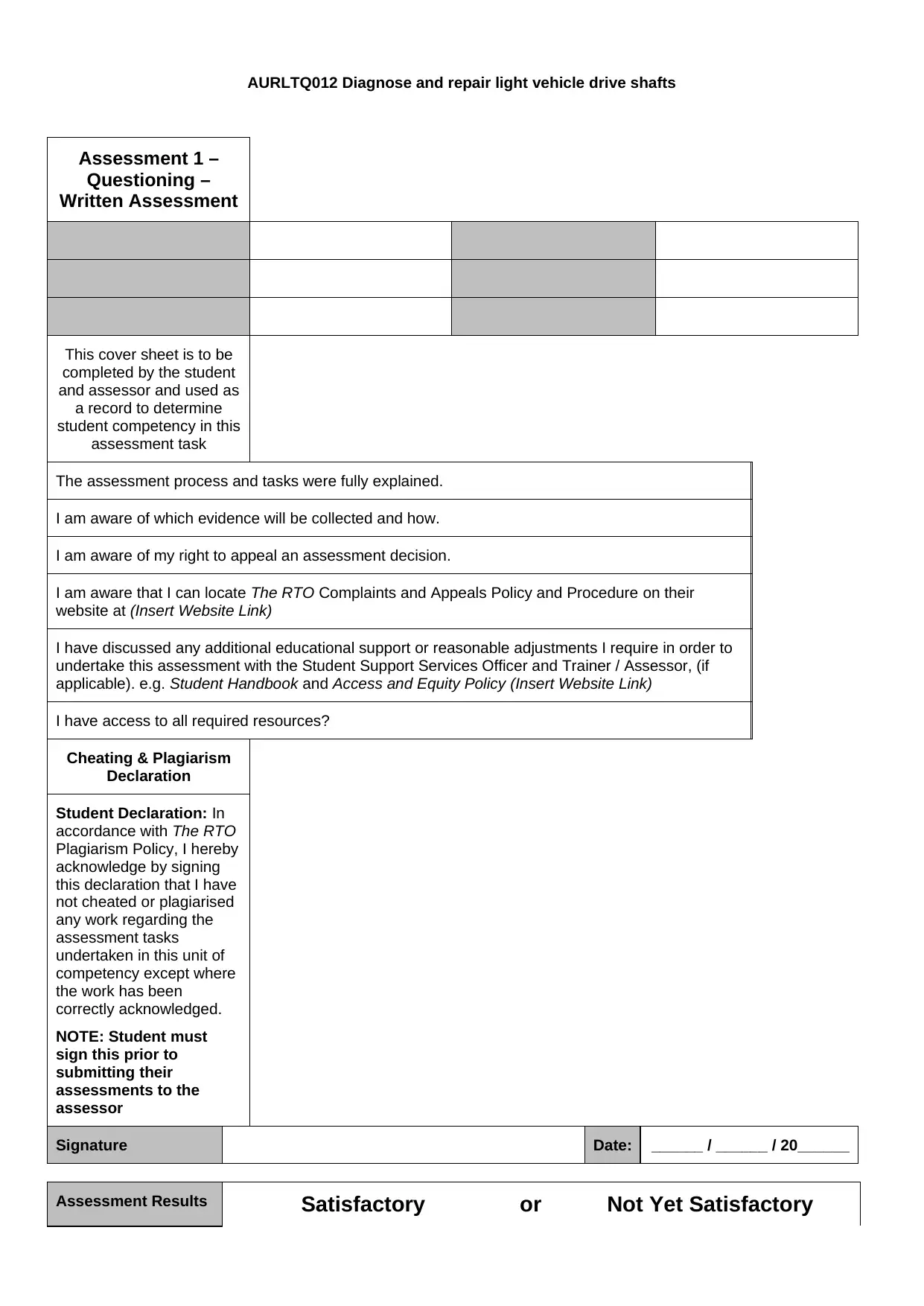
AURLTQ012 Diagnose and repair light vehicle drive shafts
Assessment 1 –
Questioning –
Written Assessment
This cover sheet is to be
completed by the student
and assessor and used as
a record to determine
student competency in this
assessment task
The assessment process and tasks were fully explained.
I am aware of which evidence will be collected and how.
I am aware of my right to appeal an assessment decision.
I am aware that I can locate The RTO Complaints and Appeals Policy and Procedure on their
website at (Insert Website Link)
I have discussed any additional educational support or reasonable adjustments I require in order to
undertake this assessment with the Student Support Services Officer and Trainer / Assessor, (if
applicable). e.g. Student Handbook and Access and Equity Policy (Insert Website Link)
I have access to all required resources?
Cheating & Plagiarism
Declaration
Student Declaration: In
accordance with The RTO
Plagiarism Policy, I hereby
acknowledge by signing
this declaration that I have
not cheated or plagiarised
any work regarding the
assessment tasks
undertaken in this unit of
competency except where
the work has been
correctly acknowledged.
NOTE: Student must
sign this prior to
submitting their
assessments to the
assessor
Signature Date: ______ / ______ / 20______
Assessment Results Satisfactory or Not Yet Satisfactory
Assessment 1 –
Questioning –
Written Assessment
This cover sheet is to be
completed by the student
and assessor and used as
a record to determine
student competency in this
assessment task
The assessment process and tasks were fully explained.
I am aware of which evidence will be collected and how.
I am aware of my right to appeal an assessment decision.
I am aware that I can locate The RTO Complaints and Appeals Policy and Procedure on their
website at (Insert Website Link)
I have discussed any additional educational support or reasonable adjustments I require in order to
undertake this assessment with the Student Support Services Officer and Trainer / Assessor, (if
applicable). e.g. Student Handbook and Access and Equity Policy (Insert Website Link)
I have access to all required resources?
Cheating & Plagiarism
Declaration
Student Declaration: In
accordance with The RTO
Plagiarism Policy, I hereby
acknowledge by signing
this declaration that I have
not cheated or plagiarised
any work regarding the
assessment tasks
undertaken in this unit of
competency except where
the work has been
correctly acknowledged.
NOTE: Student must
sign this prior to
submitting their
assessments to the
assessor
Signature Date: ______ / ______ / 20______
Assessment Results Satisfactory or Not Yet Satisfactory
Paraphrase This Document
Need a fresh take? Get an instant paraphrase of this document with our AI Paraphraser
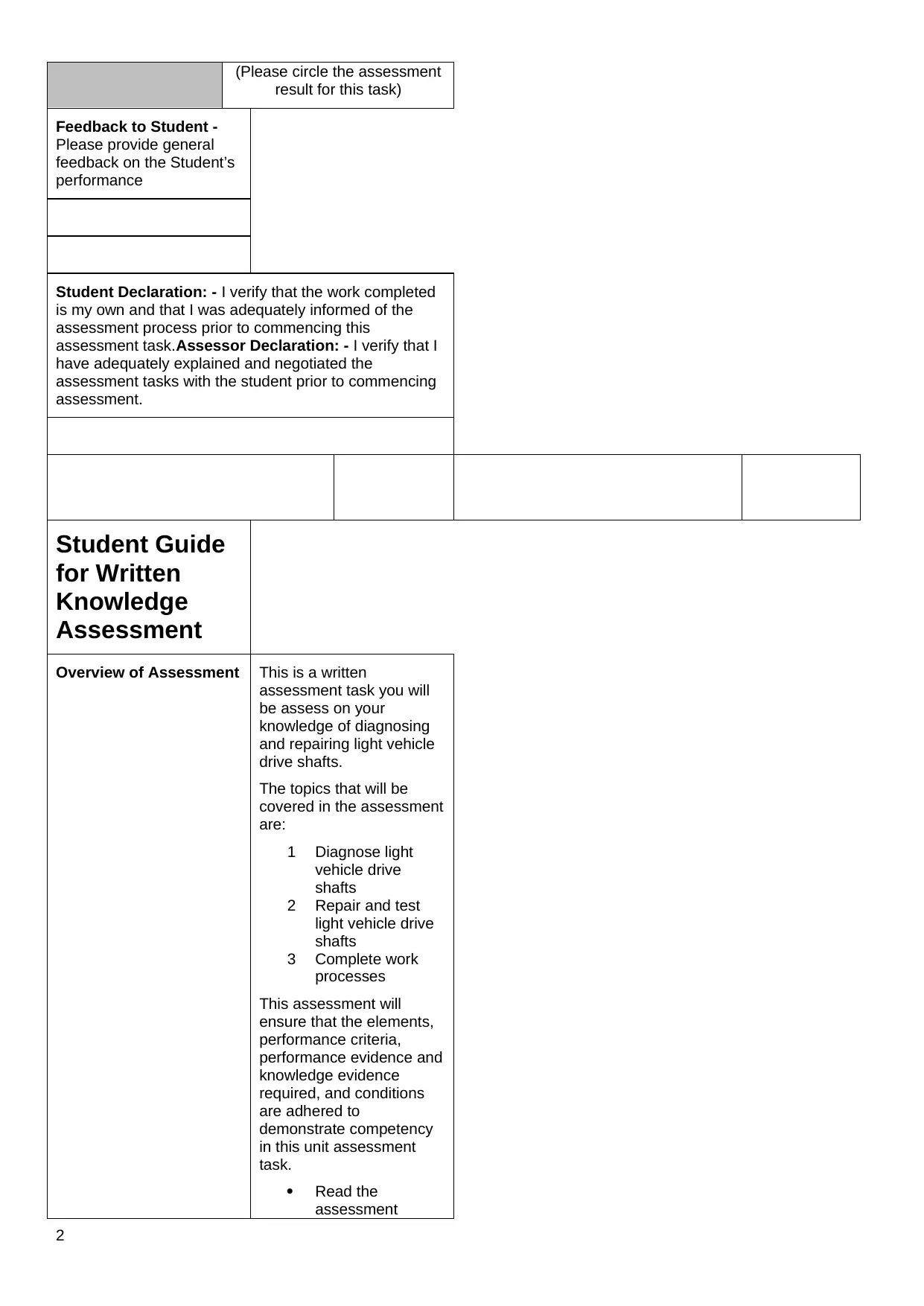
(Please circle the assessment
result for this task)
Feedback to Student -
Please provide general
feedback on the Student’s
performance
Student Declaration: - I verify that the work completed
is my own and that I was adequately informed of the
assessment process prior to commencing this
assessment task.Assessor Declaration: - I verify that I
have adequately explained and negotiated the
assessment tasks with the student prior to commencing
assessment.
Student Guide
for Written
Knowledge
Assessment
Overview of Assessment This is a written
assessment task you will
be assess on your
knowledge of diagnosing
and repairing light vehicle
drive shafts.
The topics that will be
covered in the assessment
are:
1 Diagnose light
vehicle drive
shafts
2 Repair and test
light vehicle drive
shafts
3 Complete work
processes
This assessment will
ensure that the elements,
performance criteria,
performance evidence and
knowledge evidence
required, and conditions
are adhered to
demonstrate competency
in this unit assessment
task.
Read the
assessment
2
result for this task)
Feedback to Student -
Please provide general
feedback on the Student’s
performance
Student Declaration: - I verify that the work completed
is my own and that I was adequately informed of the
assessment process prior to commencing this
assessment task.Assessor Declaration: - I verify that I
have adequately explained and negotiated the
assessment tasks with the student prior to commencing
assessment.
Student Guide
for Written
Knowledge
Assessment
Overview of Assessment This is a written
assessment task you will
be assess on your
knowledge of diagnosing
and repairing light vehicle
drive shafts.
The topics that will be
covered in the assessment
are:
1 Diagnose light
vehicle drive
shafts
2 Repair and test
light vehicle drive
shafts
3 Complete work
processes
This assessment will
ensure that the elements,
performance criteria,
performance evidence and
knowledge evidence
required, and conditions
are adhered to
demonstrate competency
in this unit assessment
task.
Read the
assessment
2
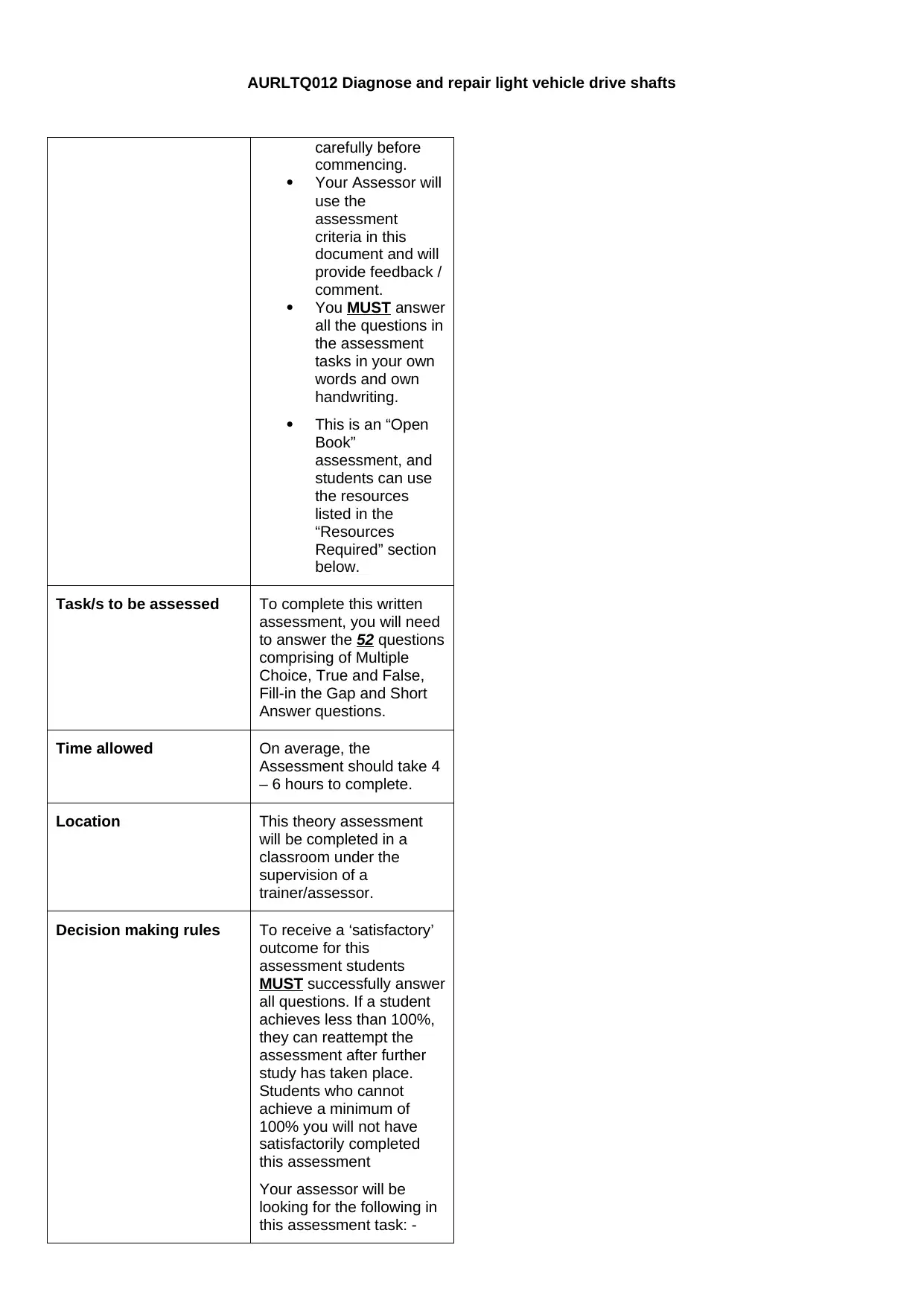
AURLTQ012 Diagnose and repair light vehicle drive shafts
carefully before
commencing.
Your Assessor will
use the
assessment
criteria in this
document and will
provide feedback /
comment.
You MUST answer
all the questions in
the assessment
tasks in your own
words and own
handwriting.
This is an “Open
Book”
assessment, and
students can use
the resources
listed in the
“Resources
Required” section
below.
Task/s to be assessed To complete this written
assessment, you will need
to answer the 52 questions
comprising of Multiple
Choice, True and False,
Fill-in the Gap and Short
Answer questions.
Time allowed On average, the
Assessment should take 4
– 6 hours to complete.
Location This theory assessment
will be completed in a
classroom under the
supervision of a
trainer/assessor.
Decision making rules To receive a ‘satisfactory’
outcome for this
assessment students
MUST successfully answer
all questions. If a student
achieves less than 100%,
they can reattempt the
assessment after further
study has taken place.
Students who cannot
achieve a minimum of
100% you will not have
satisfactorily completed
this assessment
Your assessor will be
looking for the following in
this assessment task: -
carefully before
commencing.
Your Assessor will
use the
assessment
criteria in this
document and will
provide feedback /
comment.
You MUST answer
all the questions in
the assessment
tasks in your own
words and own
handwriting.
This is an “Open
Book”
assessment, and
students can use
the resources
listed in the
“Resources
Required” section
below.
Task/s to be assessed To complete this written
assessment, you will need
to answer the 52 questions
comprising of Multiple
Choice, True and False,
Fill-in the Gap and Short
Answer questions.
Time allowed On average, the
Assessment should take 4
– 6 hours to complete.
Location This theory assessment
will be completed in a
classroom under the
supervision of a
trainer/assessor.
Decision making rules To receive a ‘satisfactory’
outcome for this
assessment students
MUST successfully answer
all questions. If a student
achieves less than 100%,
they can reattempt the
assessment after further
study has taken place.
Students who cannot
achieve a minimum of
100% you will not have
satisfactorily completed
this assessment
Your assessor will be
looking for the following in
this assessment task: -
⊘ This is a preview!⊘
Do you want full access?
Subscribe today to unlock all pages.

Trusted by 1+ million students worldwide
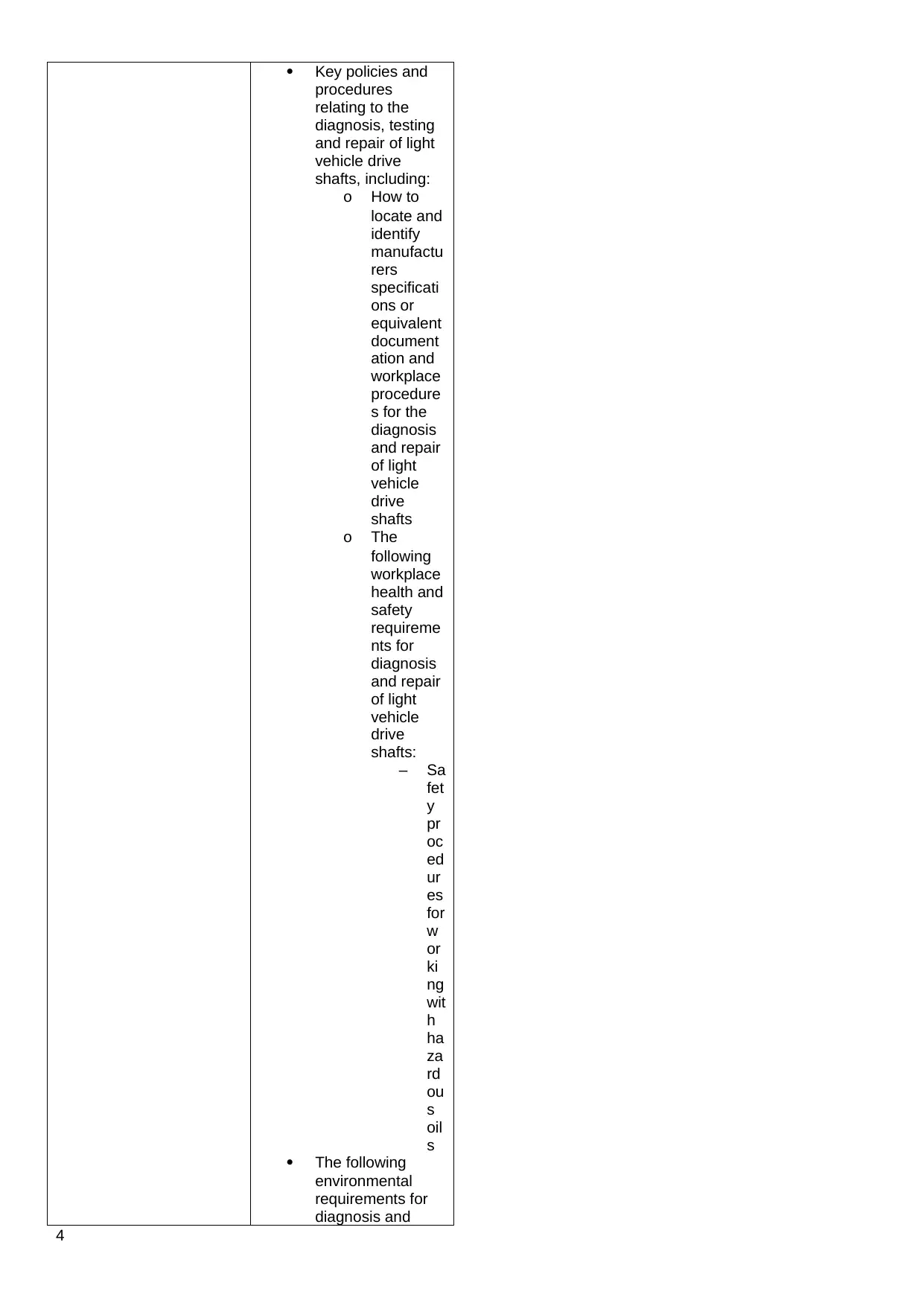
Key policies and
procedures
relating to the
diagnosis, testing
and repair of light
vehicle drive
shafts, including:
o How to
locate and
identify
manufactu
rers
specificati
ons or
equivalent
document
ation and
workplace
procedure
s for the
diagnosis
and repair
of light
vehicle
drive
shafts
o The
following
workplace
health and
safety
requireme
nts for
diagnosis
and repair
of light
vehicle
drive
shafts:
‒ Sa
fet
y
pr
oc
ed
ur
es
for
w
or
ki
ng
wit
h
ha
za
rd
ou
s
oil
s
The following
environmental
requirements for
diagnosis and
4
procedures
relating to the
diagnosis, testing
and repair of light
vehicle drive
shafts, including:
o How to
locate and
identify
manufactu
rers
specificati
ons or
equivalent
document
ation and
workplace
procedure
s for the
diagnosis
and repair
of light
vehicle
drive
shafts
o The
following
workplace
health and
safety
requireme
nts for
diagnosis
and repair
of light
vehicle
drive
shafts:
‒ Sa
fet
y
pr
oc
ed
ur
es
for
w
or
ki
ng
wit
h
ha
za
rd
ou
s
oil
s
The following
environmental
requirements for
diagnosis and
4
Paraphrase This Document
Need a fresh take? Get an instant paraphrase of this document with our AI Paraphraser
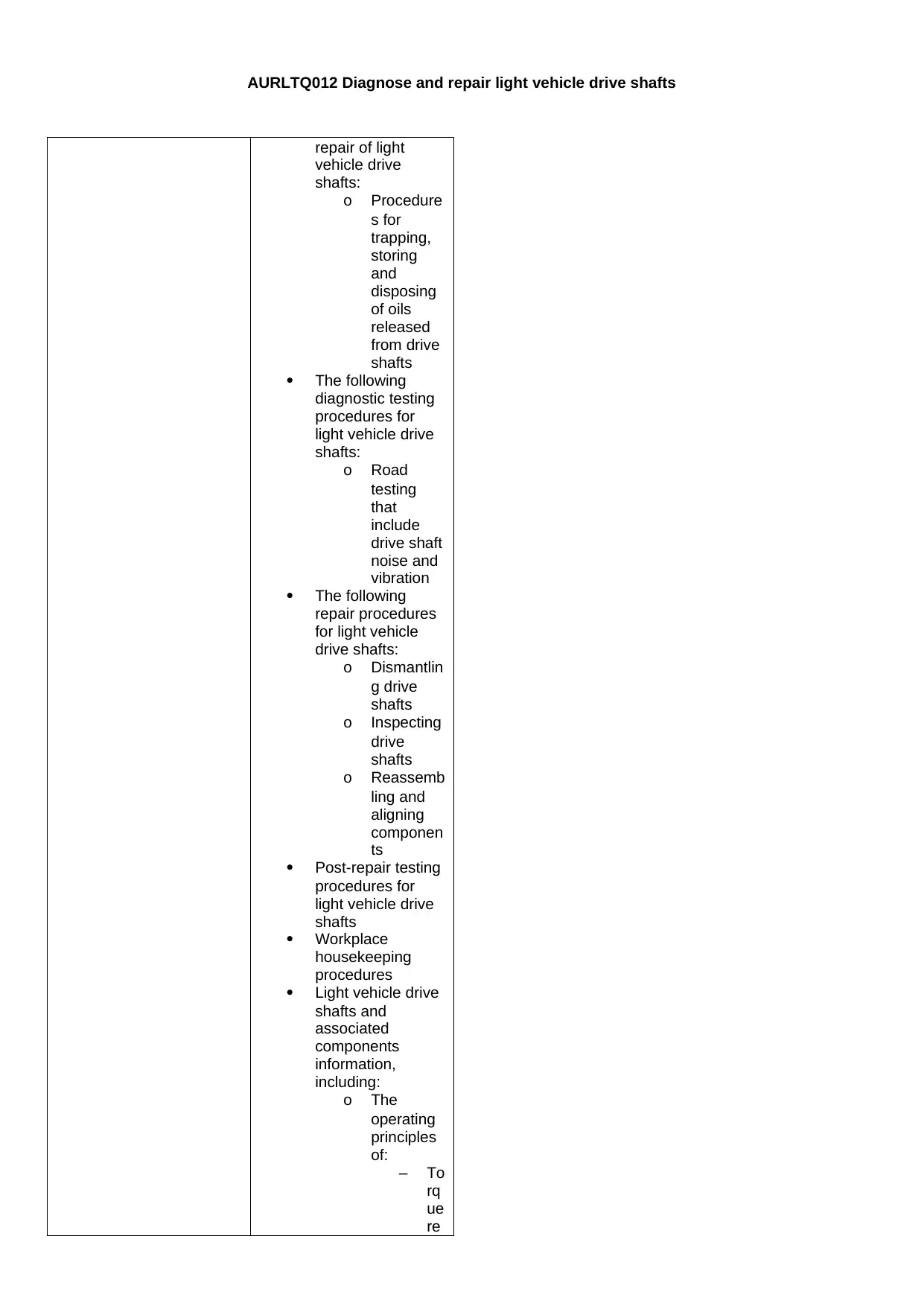
AURLTQ012 Diagnose and repair light vehicle drive shafts
repair of light
vehicle drive
shafts:
o Procedure
s for
trapping,
storing
and
disposing
of oils
released
from drive
shafts
The following
diagnostic testing
procedures for
light vehicle drive
shafts:
o Road
testing
that
include
drive shaft
noise and
vibration
The following
repair procedures
for light vehicle
drive shafts:
o Dismantlin
g drive
shafts
o Inspecting
drive
shafts
o Reassemb
ling and
aligning
componen
ts
Post-repair testing
procedures for
light vehicle drive
shafts
Workplace
housekeeping
procedures
Light vehicle drive
shafts and
associated
components
information,
including:
o The
operating
principles
of:
‒ To
rq
ue
re
repair of light
vehicle drive
shafts:
o Procedure
s for
trapping,
storing
and
disposing
of oils
released
from drive
shafts
The following
diagnostic testing
procedures for
light vehicle drive
shafts:
o Road
testing
that
include
drive shaft
noise and
vibration
The following
repair procedures
for light vehicle
drive shafts:
o Dismantlin
g drive
shafts
o Inspecting
drive
shafts
o Reassemb
ling and
aligning
componen
ts
Post-repair testing
procedures for
light vehicle drive
shafts
Workplace
housekeeping
procedures
Light vehicle drive
shafts and
associated
components
information,
including:
o The
operating
principles
of:
‒ To
rq
ue
re
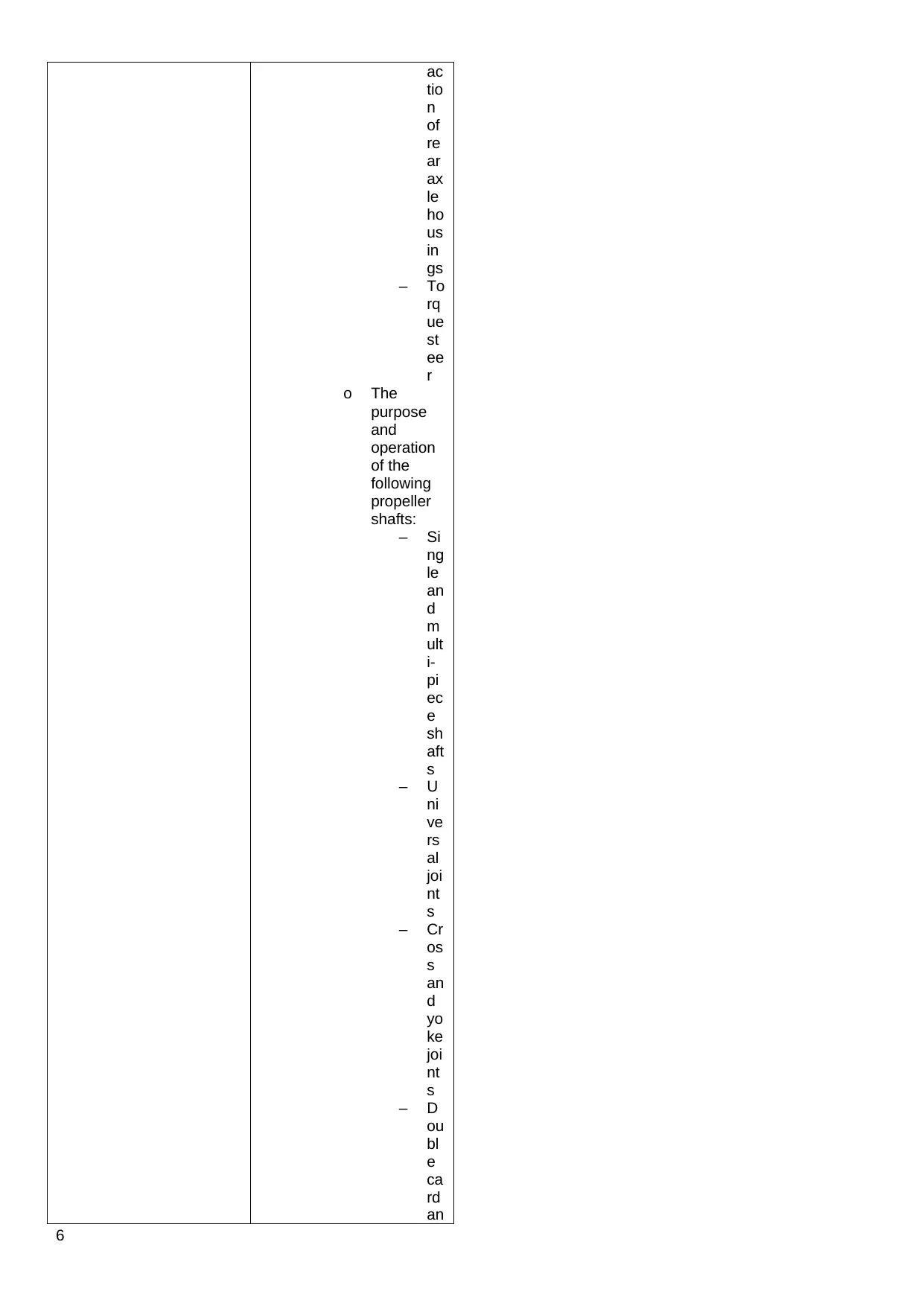
ac
tio
n
of
re
ar
ax
le
ho
us
in
gs
‒ To
rq
ue
st
ee
r
o The
purpose
and
operation
of the
following
propeller
shafts:
‒ Si
ng
le
an
d
m
ult
i-
pi
ec
e
sh
aft
s
‒ U
ni
ve
rs
al
joi
nt
s
‒ Cr
os
s
an
d
yo
ke
joi
nt
s
‒ D
ou
bl
e
ca
rd
an
6
tio
n
of
re
ar
ax
le
ho
us
in
gs
‒ To
rq
ue
st
ee
r
o The
purpose
and
operation
of the
following
propeller
shafts:
‒ Si
ng
le
an
d
m
ult
i-
pi
ec
e
sh
aft
s
‒ U
ni
ve
rs
al
joi
nt
s
‒ Cr
os
s
an
d
yo
ke
joi
nt
s
‒ D
ou
bl
e
ca
rd
an
6
⊘ This is a preview!⊘
Do you want full access?
Subscribe today to unlock all pages.

Trusted by 1+ million students worldwide
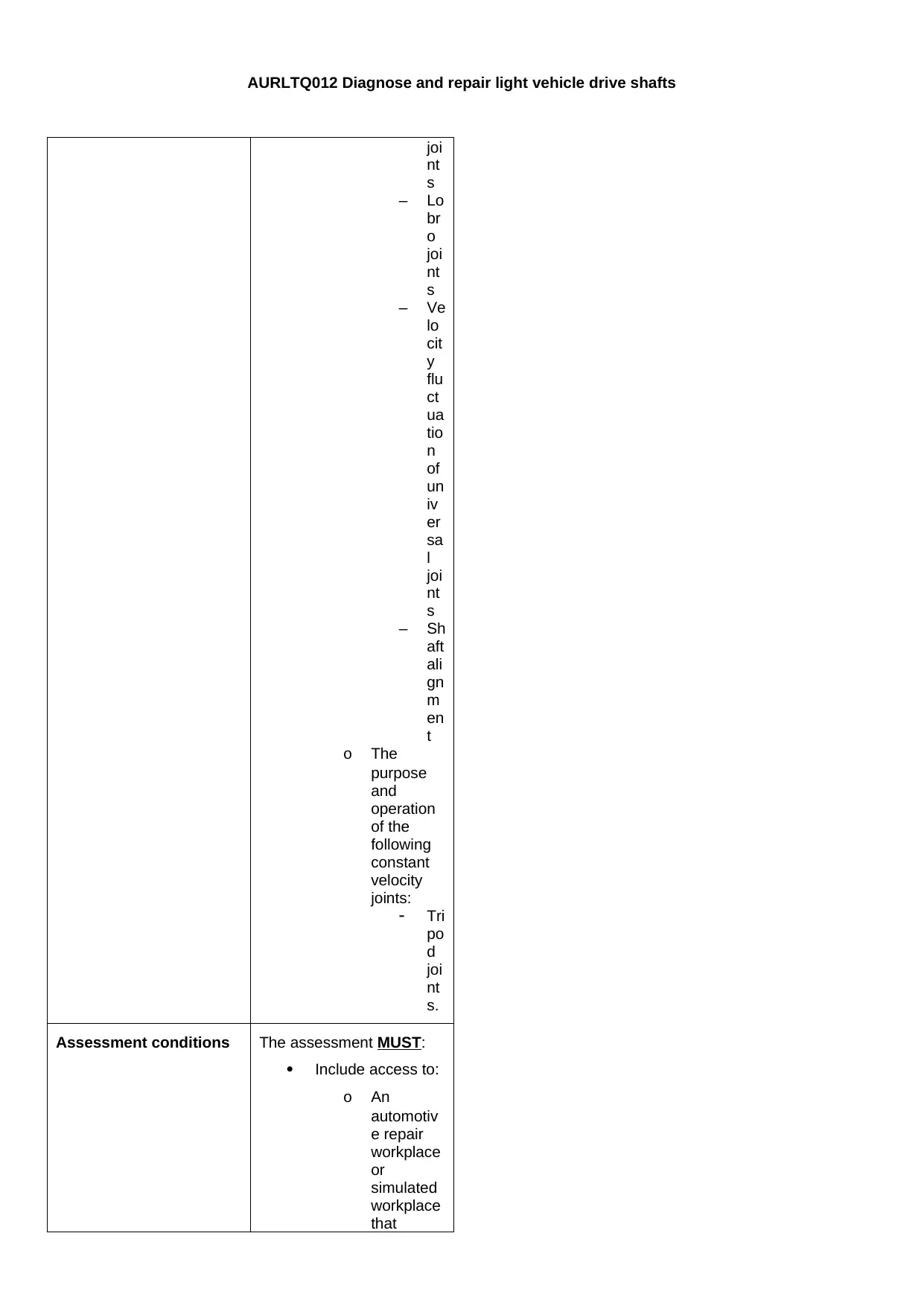
AURLTQ012 Diagnose and repair light vehicle drive shafts
joi
nt
s
‒ Lo
br
o
joi
nt
s
‒ Ve
lo
cit
y
flu
ct
ua
tio
n
of
un
iv
er
sa
l
joi
nt
s
‒ Sh
aft
ali
gn
m
en
t
o The
purpose
and
operation
of the
following
constant
velocity
joints:
Tri
po
d
joi
nt
s.
Assessment conditions The assessment MUST:
Include access to:
o An
automotiv
e repair
workplace
or
simulated
workplace
that
joi
nt
s
‒ Lo
br
o
joi
nt
s
‒ Ve
lo
cit
y
flu
ct
ua
tio
n
of
un
iv
er
sa
l
joi
nt
s
‒ Sh
aft
ali
gn
m
en
t
o The
purpose
and
operation
of the
following
constant
velocity
joints:
Tri
po
d
joi
nt
s.
Assessment conditions The assessment MUST:
Include access to:
o An
automotiv
e repair
workplace
or
simulated
workplace
that
Paraphrase This Document
Need a fresh take? Get an instant paraphrase of this document with our AI Paraphraser
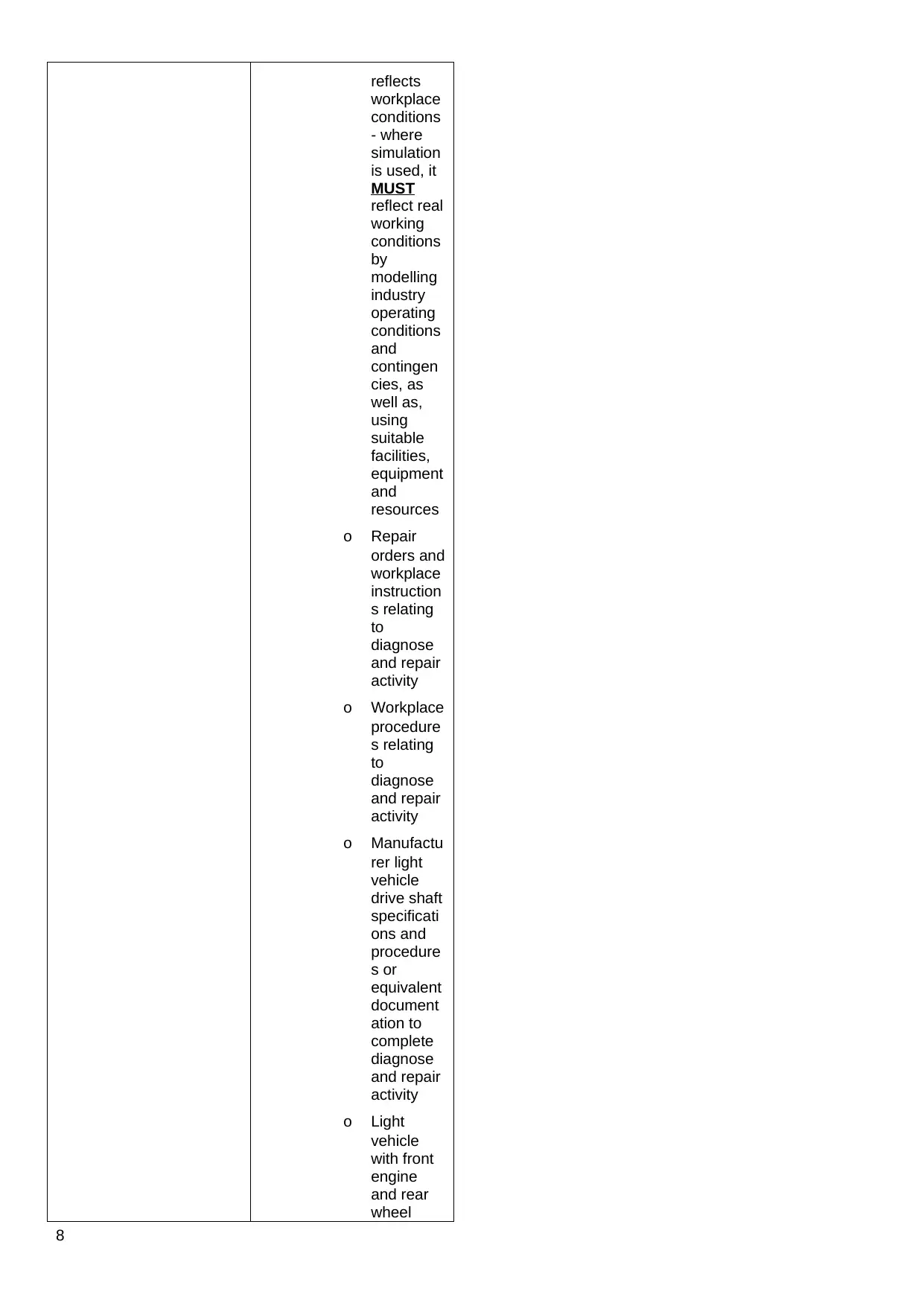
reflects
workplace
conditions
- where
simulation
is used, it
MUST
reflect real
working
conditions
by
modelling
industry
operating
conditions
and
contingen
cies, as
well as,
using
suitable
facilities,
equipment
and
resources
o Repair
orders and
workplace
instruction
s relating
to
diagnose
and repair
activity
o Workplace
procedure
s relating
to
diagnose
and repair
activity
o Manufactu
rer light
vehicle
drive shaft
specificati
ons and
procedure
s or
equivalent
document
ation to
complete
diagnose
and repair
activity
o Light
vehicle
with front
engine
and rear
wheel
8
workplace
conditions
- where
simulation
is used, it
MUST
reflect real
working
conditions
by
modelling
industry
operating
conditions
and
contingen
cies, as
well as,
using
suitable
facilities,
equipment
and
resources
o Repair
orders and
workplace
instruction
s relating
to
diagnose
and repair
activity
o Workplace
procedure
s relating
to
diagnose
and repair
activity
o Manufactu
rer light
vehicle
drive shaft
specificati
ons and
procedure
s or
equivalent
document
ation to
complete
diagnose
and repair
activity
o Light
vehicle
with front
engine
and rear
wheel
8
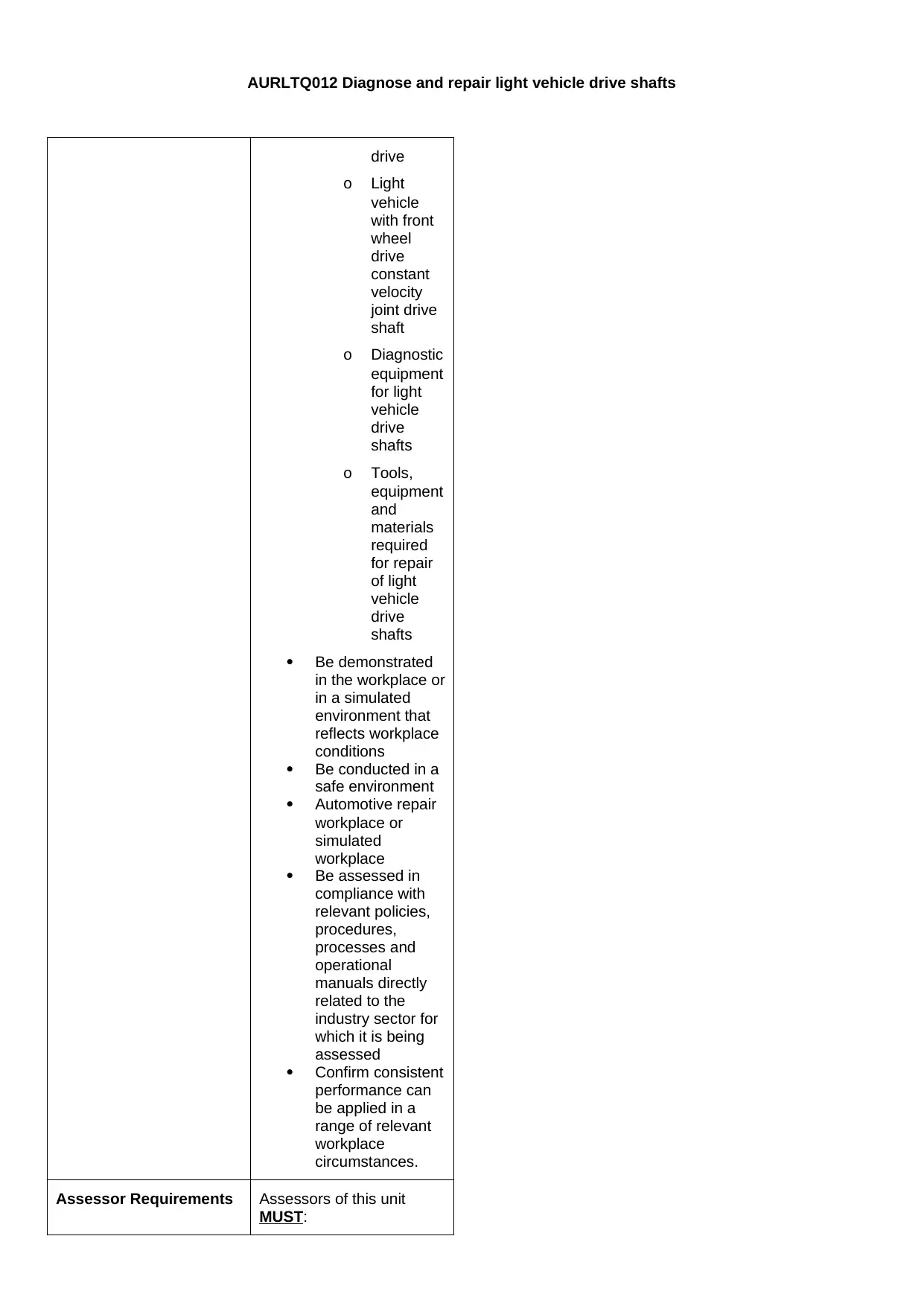
AURLTQ012 Diagnose and repair light vehicle drive shafts
drive
o Light
vehicle
with front
wheel
drive
constant
velocity
joint drive
shaft
o Diagnostic
equipment
for light
vehicle
drive
shafts
o Tools,
equipment
and
materials
required
for repair
of light
vehicle
drive
shafts
Be demonstrated
in the workplace or
in a simulated
environment that
reflects workplace
conditions
Be conducted in a
safe environment
Automotive repair
workplace or
simulated
workplace
Be assessed in
compliance with
relevant policies,
procedures,
processes and
operational
manuals directly
related to the
industry sector for
which it is being
assessed
Confirm consistent
performance can
be applied in a
range of relevant
workplace
circumstances.
Assessor Requirements Assessors of this unit
MUST:
drive
o Light
vehicle
with front
wheel
drive
constant
velocity
joint drive
shaft
o Diagnostic
equipment
for light
vehicle
drive
shafts
o Tools,
equipment
and
materials
required
for repair
of light
vehicle
drive
shafts
Be demonstrated
in the workplace or
in a simulated
environment that
reflects workplace
conditions
Be conducted in a
safe environment
Automotive repair
workplace or
simulated
workplace
Be assessed in
compliance with
relevant policies,
procedures,
processes and
operational
manuals directly
related to the
industry sector for
which it is being
assessed
Confirm consistent
performance can
be applied in a
range of relevant
workplace
circumstances.
Assessor Requirements Assessors of this unit
MUST:
⊘ This is a preview!⊘
Do you want full access?
Subscribe today to unlock all pages.

Trusted by 1+ million students worldwide
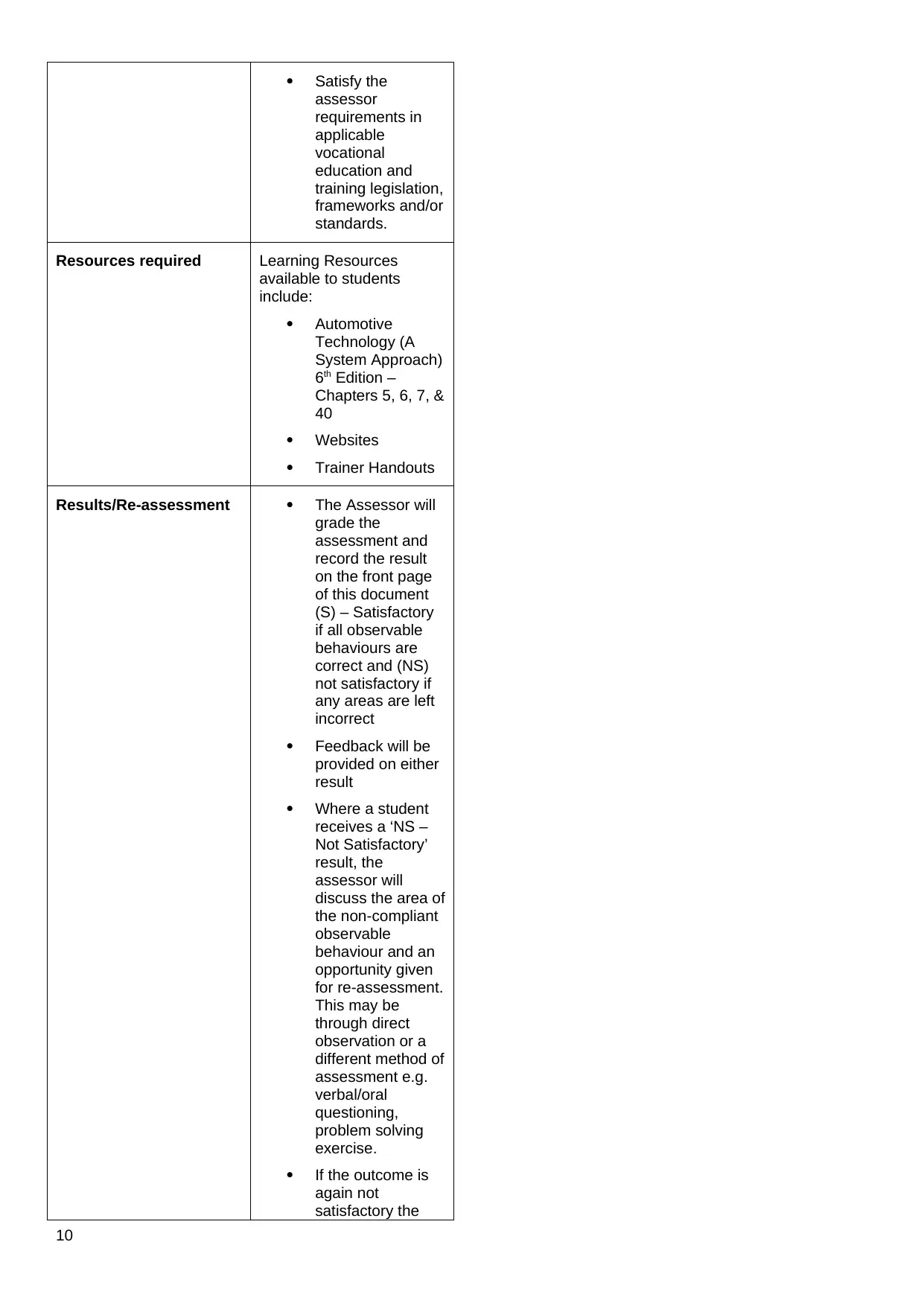
Satisfy the
assessor
requirements in
applicable
vocational
education and
training legislation,
frameworks and/or
standards.
Resources required Learning Resources
available to students
include:
Automotive
Technology (A
System Approach)
6th Edition –
Chapters 5, 6, 7, &
40
Websites
Trainer Handouts
Results/Re-assessment The Assessor will
grade the
assessment and
record the result
on the front page
of this document
(S) – Satisfactory
if all observable
behaviours are
correct and (NS)
not satisfactory if
any areas are left
incorrect
Feedback will be
provided on either
result
Where a student
receives a ‘NS –
Not Satisfactory’
result, the
assessor will
discuss the area of
the non-compliant
observable
behaviour and an
opportunity given
for re-assessment.
This may be
through direct
observation or a
different method of
assessment e.g.
verbal/oral
questioning,
problem solving
exercise.
If the outcome is
again not
satisfactory the
10
assessor
requirements in
applicable
vocational
education and
training legislation,
frameworks and/or
standards.
Resources required Learning Resources
available to students
include:
Automotive
Technology (A
System Approach)
6th Edition –
Chapters 5, 6, 7, &
40
Websites
Trainer Handouts
Results/Re-assessment The Assessor will
grade the
assessment and
record the result
on the front page
of this document
(S) – Satisfactory
if all observable
behaviours are
correct and (NS)
not satisfactory if
any areas are left
incorrect
Feedback will be
provided on either
result
Where a student
receives a ‘NS –
Not Satisfactory’
result, the
assessor will
discuss the area of
the non-compliant
observable
behaviour and an
opportunity given
for re-assessment.
This may be
through direct
observation or a
different method of
assessment e.g.
verbal/oral
questioning,
problem solving
exercise.
If the outcome is
again not
satisfactory the
10
Paraphrase This Document
Need a fresh take? Get an instant paraphrase of this document with our AI Paraphraser
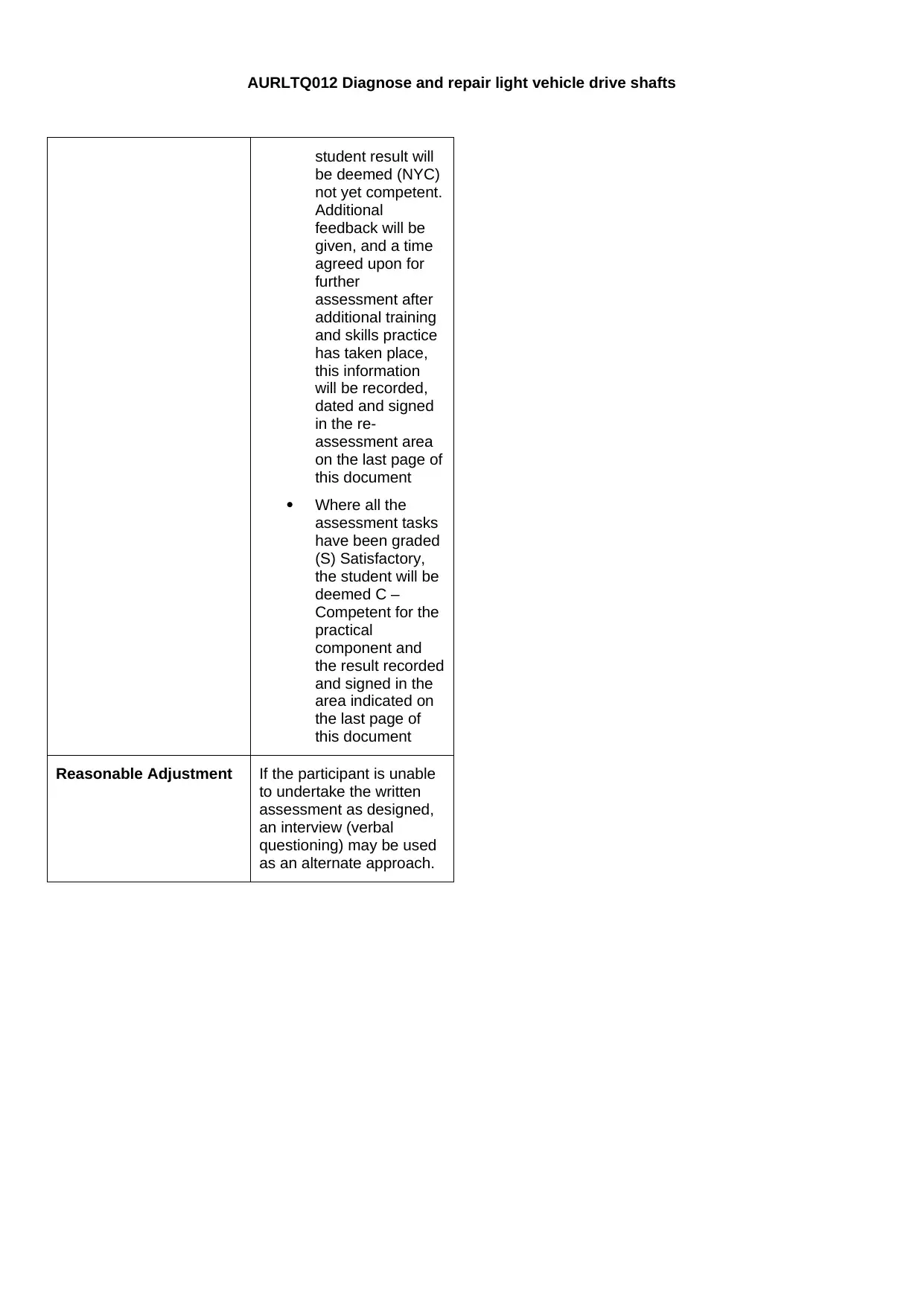
AURLTQ012 Diagnose and repair light vehicle drive shafts
student result will
be deemed (NYC)
not yet competent.
Additional
feedback will be
given, and a time
agreed upon for
further
assessment after
additional training
and skills practice
has taken place,
this information
will be recorded,
dated and signed
in the re-
assessment area
on the last page of
this document
Where all the
assessment tasks
have been graded
(S) Satisfactory,
the student will be
deemed C –
Competent for the
practical
component and
the result recorded
and signed in the
area indicated on
the last page of
this document
Reasonable Adjustment If the participant is unable
to undertake the written
assessment as designed,
an interview (verbal
questioning) may be used
as an alternate approach.
student result will
be deemed (NYC)
not yet competent.
Additional
feedback will be
given, and a time
agreed upon for
further
assessment after
additional training
and skills practice
has taken place,
this information
will be recorded,
dated and signed
in the re-
assessment area
on the last page of
this document
Where all the
assessment tasks
have been graded
(S) Satisfactory,
the student will be
deemed C –
Competent for the
practical
component and
the result recorded
and signed in the
area indicated on
the last page of
this document
Reasonable Adjustment If the participant is unable
to undertake the written
assessment as designed,
an interview (verbal
questioning) may be used
as an alternate approach.
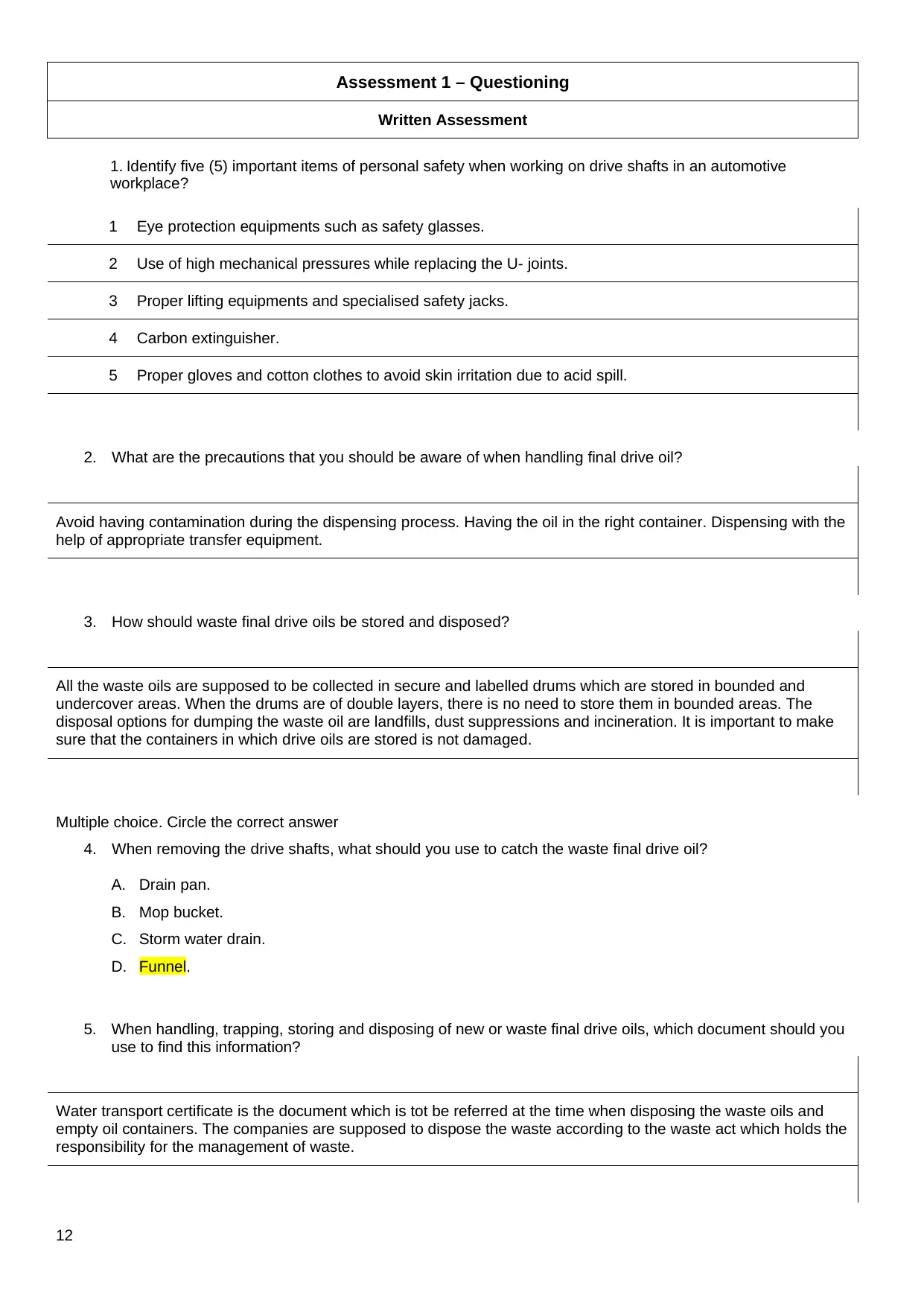
Assessment 1 – Questioning
Written Assessment
1. Identify five (5) important items of personal safety when working on drive shafts in an automotive
workplace?
1 Eye protection equipments such as safety glasses.
2 Use of high mechanical pressures while replacing the U- joints.
3 Proper lifting equipments and specialised safety jacks.
4 Carbon extinguisher.
5 Proper gloves and cotton clothes to avoid skin irritation due to acid spill.
2. What are the precautions that you should be aware of when handling final drive oil?
Avoid having contamination during the dispensing process. Having the oil in the right container. Dispensing with the
help of appropriate transfer equipment.
3. How should waste final drive oils be stored and disposed?
All the waste oils are supposed to be collected in secure and labelled drums which are stored in bounded and
undercover areas. When the drums are of double layers, there is no need to store them in bounded areas. The
disposal options for dumping the waste oil are landfills, dust suppressions and incineration. It is important to make
sure that the containers in which drive oils are stored is not damaged.
Multiple choice. Circle the correct answer
4. When removing the drive shafts, what should you use to catch the waste final drive oil?
A. Drain pan.
B. Mop bucket.
C. Storm water drain.
D. Funnel.
5. When handling, trapping, storing and disposing of new or waste final drive oils, which document should you
use to find this information?
Water transport certificate is the document which is tot be referred at the time when disposing the waste oils and
empty oil containers. The companies are supposed to dispose the waste according to the waste act which holds the
responsibility for the management of waste.
12
Written Assessment
1. Identify five (5) important items of personal safety when working on drive shafts in an automotive
workplace?
1 Eye protection equipments such as safety glasses.
2 Use of high mechanical pressures while replacing the U- joints.
3 Proper lifting equipments and specialised safety jacks.
4 Carbon extinguisher.
5 Proper gloves and cotton clothes to avoid skin irritation due to acid spill.
2. What are the precautions that you should be aware of when handling final drive oil?
Avoid having contamination during the dispensing process. Having the oil in the right container. Dispensing with the
help of appropriate transfer equipment.
3. How should waste final drive oils be stored and disposed?
All the waste oils are supposed to be collected in secure and labelled drums which are stored in bounded and
undercover areas. When the drums are of double layers, there is no need to store them in bounded areas. The
disposal options for dumping the waste oil are landfills, dust suppressions and incineration. It is important to make
sure that the containers in which drive oils are stored is not damaged.
Multiple choice. Circle the correct answer
4. When removing the drive shafts, what should you use to catch the waste final drive oil?
A. Drain pan.
B. Mop bucket.
C. Storm water drain.
D. Funnel.
5. When handling, trapping, storing and disposing of new or waste final drive oils, which document should you
use to find this information?
Water transport certificate is the document which is tot be referred at the time when disposing the waste oils and
empty oil containers. The companies are supposed to dispose the waste according to the waste act which holds the
responsibility for the management of waste.
12
⊘ This is a preview!⊘
Do you want full access?
Subscribe today to unlock all pages.

Trusted by 1+ million students worldwide
1 out of 26
Related Documents
Your All-in-One AI-Powered Toolkit for Academic Success.
+13062052269
info@desklib.com
Available 24*7 on WhatsApp / Email
![[object Object]](/_next/static/media/star-bottom.7253800d.svg)
Unlock your academic potential
Copyright © 2020–2025 A2Z Services. All Rights Reserved. Developed and managed by ZUCOL.





